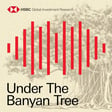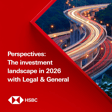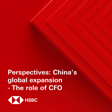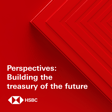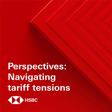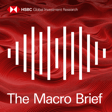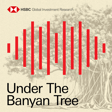Become a Creator today!Start creating today - Share your story with the world!
Start for free
00:00:00
00:00:01

Under the Banyan Tree – ASEAN’s tariff advantage
ASEAN Economist Aris Dacanay joins Herald and Fred to explain why Southeast Asian economies could actually see rising market share across various sectors as a result of US import tariffs.
Disclaimer: https://www.research.hsbc.com/R/101/W9vcfSd
Stay connected and access free to view reports and videos from HSBC Global Investment Research, just search for #HSBCResearch on LinkedIn or click here: https://www.gbm.hsbc.com/insights/global-research.
Transcript
Introduction to HSBC Global Viewpoint
00:00:01
Speaker
Welcome to HSBC Global Viewpoint, the podcast series that brings together business leaders and industry experts to explore the latest global insights, trends, and opportunities.
00:00:13
Speaker
Make sure you're subscribed to stay up to date with new episodes. Thanks for listening, and now onto today's show.
Under the Banyan Tree: Focus on Asian Markets
00:00:33
Speaker
Hello from HSBC Hong Kong and welcome to Under the Banyan Tree where we put Asian markets and economics in context. I'm Fred Newman, Chief Asia Economist. And I'm Harold Wendelin, the head of Asian Equity Strategy. We've got a fresh take on a tariff story for you today with a focus on Southeast Asia.
Can ASEAN Economies Gain US Market Share?
00:00:49
Speaker
That's right. Despite the obstacles to trade that tariffs create, ASEAN economies actually stand to see their market share in the U.S. increase. How is that possible? Here to tell us is ASEAN economist Aris Takane, our guest in the studio this week.
00:01:04
Speaker
Let's get the conversation started right here on The Domain Entry.
00:01:15
Speaker
Well, we're joined here by Aris Dakinay, our specialist on ASEAN economies. Welcome, Aris. Hello, hello. Thank you for having me. Not the first time, Aris. You're regular here under the Banyan tree, I have to say.
ASEAN vs China: US Import Dynamics
00:01:28
Speaker
um we're We're delighted to have you here, and partly because he wrote a very interesting report of late looking at how Southeast Asia, the ASEAN economies, might sort of fare under these growing terrors by the US.
00:01:42
Speaker
And I think the general assumption is that higher terrors in the US ultimately are not good for economies in Southeast Asia that export a lot to the US. But um you found actually that, yes, there are some headwinds, but there are also some positives and lightness.
00:02:00
Speaker
So, fun fact, did you know that ever since March of this year, and for the first time since the year 2000, the US has imported more from Southeast Asia than from China by around $61 billion. Wait, this is a fun fact for me because this is a surprise.
00:02:17
Speaker
Everybody always talks about the big trade between China and the US, but you're saying that Southeast Asia as a group exports more to
Impact of US Tariff Exemptions on ASEAN
00:02:24
Speaker
the US. Indeed. Wow. Now, wait, wait, there might be a statistical mirage yeah here. No, because I'm thinking as well. Yeah, so is that partly just goods being rerouted? Will they slap on a label? so they They ship stuff from China to Vietnam, put a different label and send it to U.S.? s So some may be re-exports, but some are actually a genuine increase of the market share, or at least the U.S. s generally buy more goods from Southeast Asia,
00:02:52
Speaker
than from China. And they are very specific goods, but they're particularly goods where the tariff rates or at least the U.S. tariffs are exempted. That's interesting. So what you're saying is that there is a lot of local production going on in Southeast Asia, not just transshipments. But even for the transshipments, is that the case? Or is there must be transshipments taking place, right? So China goes to Vietnam, they put a sticker on it and goes to the U.S. Or is my mistake in here?
00:03:18
Speaker
um I do have to say that even though there are a certain components or at least a lot of components from China that is being re-exported through Southeast Asia, they are still being assembled by Southeast Asia. Okay, so something happens and it's just on the sticker. Yes, that's still growing. They assemble or they put it together or whatever it is, right? Okay, good. So so a lot of...
00:03:41
Speaker
Genuine production in Southeast Asia. Now, why would there still be a genuine increase in production Southeast Asia compared
Industry-Specific Benefits for ASEAN
00:03:50
Speaker
to China? Why is it that we still see production moving from China to Southeast Asia? Why why why is China losing market share and ASEAN is they gaining market So we have to look at it on a buy industry basis.
00:04:03
Speaker
And this U.S. tariff regime, there are some industries that are exempted from U.S. tariffs. And you could actually see that goods that are exempted from these tariffs are actually where growth is coming from. Wait, wait. For me, just to quickly understand, right?
00:04:19
Speaker
But I thought there were just tariffs slapped on these countries. So 20, 30 percent. So all these goods are being impacted. Or you say that there are particular goods where they have much lower tariffs. And that's where the advantage is. Or at least a lower tariff than China.
00:04:32
Speaker
ok A larger tariff advantage. These are automobiles, fully built in parts. These are your um lumber products, such as your cabinets from Vietnam, your sofas from Indonesia.
00:04:45
Speaker
So just to get this right, so you're saying under the current tariffs and new tariffs, actually a lot of sort of exemptions or different rules for individual industries. And in these areas, Southeast Asia has actually lower tariffs than China has.
00:05:00
Speaker
And therefore, Southeast Asia has a competitive and advantage. indeed Wow. Indeed.
Thailand's HDD Advantage Over China
00:05:06
Speaker
Give us an example. So let's say HDDs, hard disk drives. Five years ago, it was HDDs in laptops. Now it's SSDs. But HDDs are basically facing a renaissance.
00:05:17
Speaker
ah Data centers need a lot of HDDs. that's right And there's a lot of data centers that's being built in the U.S., So where did they get it from? So China is the number one producer of HDDs.
00:05:29
Speaker
A close second is Thailand. But an HDD in Thailand is now 20% cheaper because of tariff rates, the wider differential tariff advantage, than China.
00:05:40
Speaker
So the U.S. has shifted its purchases of HDDs from China to tot to Thailand. Despite there being tariffs, there's just lower tariffs than in China. That's interesting. that's interesting But is that does that also apply? if I want to buy a sofa in the US, if I was American buying a sofa from China, now it's I have these tariffs, it's much more expensive, do I then buy a Vietnamese sofa now?
00:06:02
Speaker
Indeed, ah Vietnam produces a lot of sofas, um Indonesia produces a lot of sofas, and the Philippines actually produces a lot of high-end sofas, those that are made in Rattan.
00:06:12
Speaker
But sofas are ah only a small market, right? So HDDs, these hard disk drives, that I can see that is something that's really significant, right? Well, you also mentioned automotive, semiconductors, right? So there's a lot of products here, right?
00:06:26
Speaker
That's a lot of products, indeed. So SSDs, you have you even pet food. So the picture that emerges from here, so what I'm surprised about, one, is that ASEAN is exporting a lot and is now a bigger exporter to the US than China.
00:06:41
Speaker
And secondly, although I presume trade is down and growth is down because of these tariffs, for ASEAN there are kind of, call it mitigating factors. It's probably not as bad, right?
00:06:52
Speaker
Yeah, well, I mean, we started off saying that the tariffs are still not good for these economies. It's just in certain sectors, we're seeing ASEAN actually gaining market share. So we're still left with a bit of a growth challenge here for the region overall. So what can these policymakers then do? So ASEAN, they are being supported to certain extent by market share gains and in exports. So the export sector is not as bad, but they need to do something. What what levers can they pull?
00:07:19
Speaker
So a lot of these Southeast Asian economies have actually used fiscal policy in 2025 to try to pick up the slack in terms of trade. So for example, you have Thailand with an expansionary policy in Indonesia.
00:07:34
Speaker
And for the Philippines, it actually went to a different direction. For the Philippines, ah it's... They are in a gradual consolidation of fiscal resource, but instead of of spending more, they decided to spend wisely, more wise like wiser in a way, that you get to spend less on projects that you think are not doing too much and and spend more on social aspects. So they don't much more targeting for yes yes kind of spending. ok That's interesting.
Domestic Growth Potential in ASEAN
00:08:06
Speaker
Southeast Asia is so export dependent and if there are tariffs coming through, even if you gain market share in some sectors, where are the opportunities then for these economies? So let's take a quick break here and then we come back. We'll talk about domestic story.
00:08:29
Speaker
So we've learned so far from Aries here that actually the exports are doing relatively better. They are gaining markets here in ASEAN. So that's a good thing. But these are still large domestic markets, right? I mean, Indonesia's got 270, 280 million people.
00:08:43
Speaker
Vietnam is probably about 100. Philippines, 100? 115. Yes. So these are actually, sometimes we forget about these. These are actually very large ah places. A lot of people living there.
00:08:54
Speaker
um And these are domestic-oriented markets. So... What levers can they pull to deal with this slowdown in growth? We have to relate it to how exports translate to the domestic economy.
00:09:06
Speaker
And these tariffs are mostly focused on manufacturing. And you notice that these ASEAN economies that are more focused on manufacturing, job creation isn't really doing that well. Yeah, that's a pity. So it doesn't translate into jobs for people. Yes.
00:09:20
Speaker
So because of that, a lot of these governments, a lot of these economies have tried to use the fiscal and monetary levers to try to pick up the slack. So basically spending by the government yeah and interest rates are being cut. Yes.
00:09:32
Speaker
but But you mentioned something um before the break, Aris, and that is the quality of fiscal spending. and I want to pick you up on that because if really the idea here is to create more of a domestic demand, you really probably need to focus on infrastructure, on Improve logistics. Logistics, services sector, just to generate underlying growth.
00:09:52
Speaker
um But the risk must then also be that maybe some of the spending goes into less productive uses. I'm thinking, ah for example, subsidies, just spending vouchers, for example, which give you a short term.
00:10:07
Speaker
Kind feeling good. You can spend the something more but then it peters out, right? It's not sustainable.
ASEAN's Fiscal Policies for Sustainable Growth
00:10:11
Speaker
do Do we see see signs of this this more structural ah focus coming in? I think Vietnam very much focused on the infrastructure.
00:10:18
Speaker
So you do have Vietnam and the Philippines focusing more on infrastructure, but we have to also look at it at the lens that we just came from COVID-19. A lot of these people are just recently employed fiscal stimulus, so yeah yeah in got a lot of debt.
00:10:35
Speaker
So you have to take in note the room of fiscal policy. Philippines does not have a large room. And let's also be frank. We've seen people coming to the streets across ASEAN because I can understand this now where this comes from. There's not enough job creation.
00:10:50
Speaker
The economies are being hit. Fiscal spending takes place, but some of that leaks. COVID was tough on people in Southeast Asia. COVID was really tough. So for a lot of people, this has been a couple of really difficult years. And I can understand there's a sort of sometimes frustration boils over, right? Yeah.
00:11:04
Speaker
So there's a there's pressure in Southeast Asia to be able to employ you know fiscal policy that directly translates to spending immediately. yeah So for example, you have Thailand with a co-payment scheme. um You have the Indonesia with the free meals program.
00:11:21
Speaker
But with economies that have a tighter fiscal space, for example, the Philippines, They have to be more targeted. They have to be more targeted. And this is Fred's point, that actually that might be good because that targeted means you you put something in place that is sustainable for the next couple of years.
00:11:35
Speaker
And it's so easy sometimes to give out vouchers or do something else that feels good now, but it really peters out after six months. Nevertheless, um the broader point here is I think that, yes, exports are a bit at risk from tariffs in the U.S., but ASEAN has some opportunities in some sectors to expand market share.
00:11:54
Speaker
But there needs to be a focus on the domestic economies. And there's a lot of potential there in all
Can ASEAN's Equity Markets Thrive?
00:12:00
Speaker
these markets. and And maybe for a final thought, Harold, equity markets. yes They should be benefiting ultimately from a focus on domestic markets because often the export sector is not what's represented on the stock market. No, no, but this is why I found this discussion really interesting because for me, if I look at the equity market, growth is is under pressure for a lot of corporates, but there's a lot of hope that things will improve. And this comes back that exports are weak, the economies are weak, but there is this fiscal stimulus taking place and that should then translate into better businesses, more sales and profits for companies.
00:12:38
Speaker
But we're not quite sure where we stand on this front. And this is why the ASEAN markets are yeah struggling a little bit. I mean, all the excitement at the moment is North Asia, AI and these sort of things. But it could well be that if this works, then next year, yeah, focus will be back on those markets.
00:12:52
Speaker
Well, General, this reminds me little bit of China, actually. We're looking at a growth, a hopeful growth rotation from the export sector to the domestic side. So ASEAN is in that sense... Similar to China, but it's fascinating research, ours on the ASEAN region here and reminding us that even if they're headwinds on growth, there are sectors where actually ASEAN is still doing okay, such as I think I'll be ending up buying my sofa from Vietnam. And I might, I have refurbishing my house. I might look at Vietnamese solvers or maybe the Philippine solvers, the high-end ones. Yeah, the high-end ones. Yeah, yeah. But anyways, thanks for joining us on the Banyan Tree. Yes. Aris, and I hope to invite you again soon. Thank you for having me.
00:13:32
Speaker
And that brings us to the end of another great conversation here under the Banyan Tree. Thanks, everybody, for listening around the world. And please do subscribe to us in our sister podcast, The Macro Brief, if you haven't done so already.
00:13:45
Speaker
Under the Banyan Tree is an HSBC Global Investment Research production. Thanks for joining us and talk to you again next week.
00:14:24
Speaker
Thank you for joining us at HSBC Global Viewpoint. We hope you enjoyed the discussion. Make sure you're subscribed to stay up to date with new episodes.




